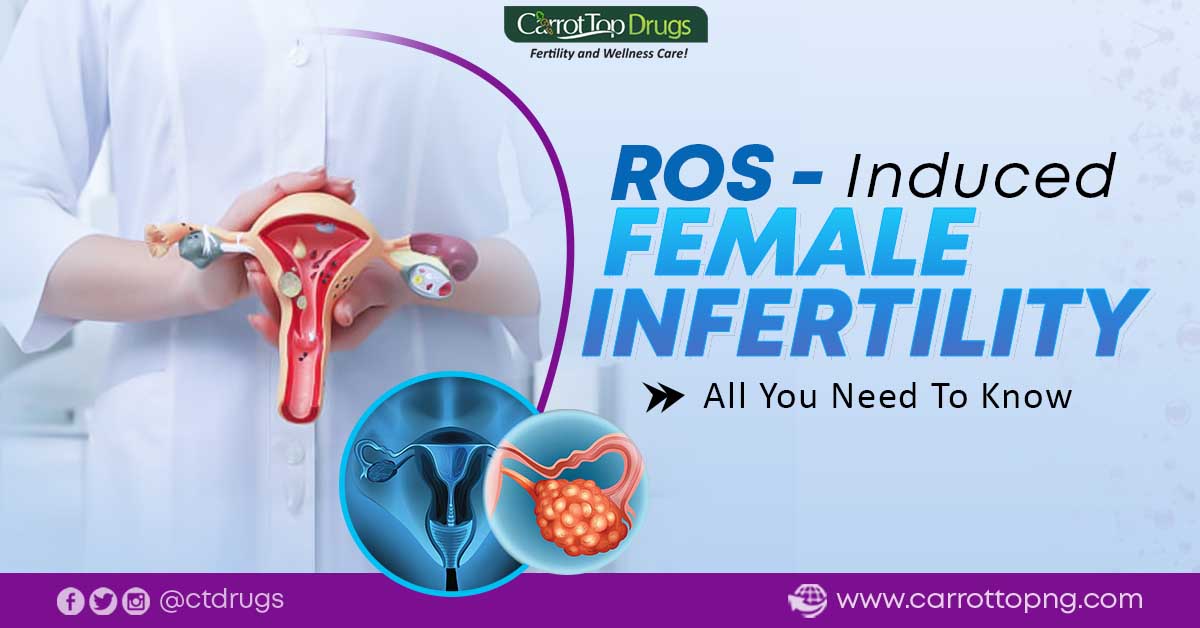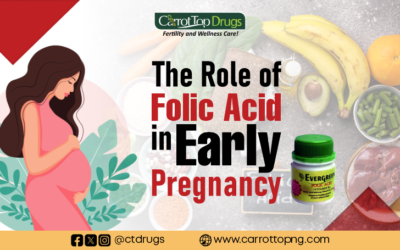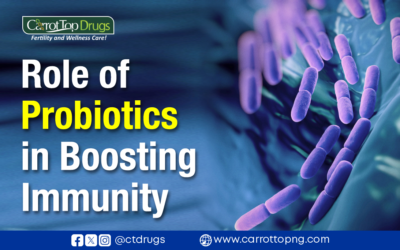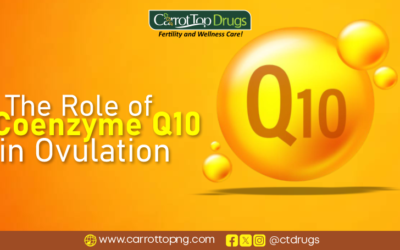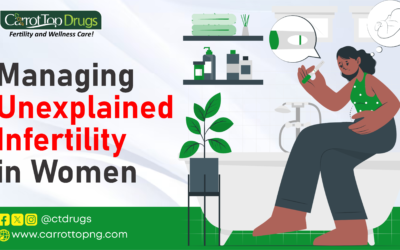Introduction
Female infertility is a complex issue that affects millions of women worldwide. In recent years, researchers have focused on understanding the impact of reactive oxygen species (ROS) on female reproductive health. ROS are highly reactive molecules that are formed as byproducts of cellular metabolism. While they play essential roles in various physiological processes, an excess of ROS can lead to oxidative stress and damage to cells and tissues. When this result in infertility, we refer to it as ROS-induced female infertility.
This article aims to explore the connection between ROS and female infertility, shedding light on the mechanisms involved and potential treatment approaches.
Understanding ROS
ROS, also known as free radicals, are chemically active molecules that contain oxygen and have unpaired electrons. They are naturally produced in the body during normal cellular processes, such as metabolism and immune system functioning. However, external factors such as pollution, smoking, and radiation exposure can also contribute to increased ROS production. The delicate balance between ROS production and the body’s antioxidant defense systems is crucial for maintaining cellular homeostasis.
ROS and Female Infertility
The impact of ROS on female fertility has gained significant attention in recent years. Excessive levels of ROS can negatively affect various aspects of reproductive health, including ovarian function, oocyte quality, and the development of conditions like endometriosis.
Impact on Ovarian Function
ROS-induced oxidative stress can have a detrimental impact on ovarian function, affecting various stages of follicle development and ovulation. ROS plays a significant role in ROS-induced female infertility by disrupting the delicate hormonal balance required for normal ovarian function. They can impair follicle development, interfere with ovulation, and disrupt the release of sex hormones necessary for fertility.
During follicle development, ROS can interfere with the growth and maturation of ovarian follicles, contributing to ROS-induced female infertility. The excessive production of ROS can cause oxidative damage to the follicular cells and DNA. This impairs the development and maturation of the follicles. This oxidative stress in the ovaries can lead to a decrease in the number of healthy follicles. This reduces the chances of successful ovulation and subsequent conception.
Also, excessive ROS can interfere with ovulation, leading to ROS-induced female infertility. The signaling pathways involved in ovulation can be disrupted by the imbalanced levels of ROS. This imbalance can affect the release of luteinizing hormone (LH) and follicle-stimulating hormone (FSH). These hormones are necessary for the proper maturation and release of the egg. Consequently, irregular or anovulatory cycles can occur, further diminishing the chances of achieving pregnancy.
Furthermore, ROS can disrupt the production of sex hormones in the ovaries, contributing to ROS-induced female infertility. Estrogen and progesterone are essential hormones for reproductive health. Imbalances in these hormones due to ROS can lead to hormonal disturbances. This affects the quality of the endometrium and makes it less receptive to implantation. This imbalance can significantly impact the ability to conceive and maintain a pregnancy.
Effects on Oocyte Quality
ROS-induced female infertility can have a significant impact on oocyte quality, leading to reduced fertility outcomes. Oocytes, or eggs, are highly sensitive to oxidative stress. Increased ROS levels can directly affect their development and quality.
The excessive production of ROS can result in oxidative damage to the genetic material within the oocyte. This results in DNA strand breaks and mutations. This DNA damage can impair the integrity and stability of the genetic material. Thus, increasing the risk of chromosomal abnormalities. These chromosomal abnormalities can significantly compromise the oocyte’s viability and its potential to develop into a healthy embryo upon fertilization.
Moreover, excessive ROS can affect cellular functions within the oocyte, further contributing to ROS-induced female infertility. Oocytes are complex cells that undergo intricate processes during maturation, including:
- energy production,
- protein synthesis, and
- organelle development.
ROS can disrupt these essential cellular functions by impairing mitochondrial function and protein synthesis machinery. As a result, oocytes exposed to high levels of ROS may experience metabolic dysfunction, reduced energy production, and impaired cellular processes necessary for successful fertilization and embryo development.
Role in Endometriosis
ROS-induced female infertility plays a significant role in the development and progression of endometriosis. Endometriosis is a condition where endometrial tissue grows outside the uterus. The presence of ROS in the pelvic cavity can contribute to the pathogenesis of endometriosis through the induction of inflammation and oxidative stress.
In endometriosis, the abnormal growth of endometrial tissue outside the uterus can lead to the formation of lesions, adhesions, and cysts in the pelvic area. These lesions can cause chronic inflammation, pain, and scarring, ultimately affecting fertility. ROS-induced oxidative stress has been identified as a key player in the development of endometriosis.
ROS can promote the growth and invasion of endometrial tissue in the pelvic cavity. This exacerbates the inflammatory response in endometriosis. ROS can activate various signaling pathways that stimulate the proliferation, migration, and adhesion of endometrial cells to other pelvic organs and tissues. This abnormal growth and invasion of endometrial tissue contribute to the formation of endometriotic lesions, which can further release more ROS, creating a vicious cycle of oxidative stress and inflammation.
Furthermore, excessive ROS can directly damage the DNA of endometrial cells. This damage impairs their normal function and promotes the development of endometriosis. The DNA damage caused by ROS can lead to genetic mutations and alterations in gene expression. This disrupts the regulation of cell growth and survival. These changes can contribute to the survival and proliferation of endometrial cells outside the uterus, promoting the establishment and progression of endometriotic lesions.
Mechanisms of ROS-Induced Infertility
There are several mechanisms that contribute to the detrimental effects of ROS on female fertility. Oxidative stress, inflammation, and DNA damage are among the key processes involved.
Oxidative Stress
Excessive ROS production overwhelms the body’s antioxidant defense systems, leading to oxidative stress. This imbalance can cause cellular damage and disrupt normal cellular functions, including those essential for reproductive health.
Inflammation
ROS can trigger an inflammatory response in the reproductive system, leading to tissue damage and dysfunction. Chronic inflammation can impair the proper functioning of the ovaries, fallopian tubes, and uterus, affecting fertility.
DNA Damage
ROS can cause DNA damage by oxidizing cellular components and disrupting the integrity of genetic material. This can result in chromosomal abnormalities and impair the ability of fertilized eggs to develop into healthy embryos.
Lifestyle Factors and ROS-induced Female Infertility
Several lifestyle factors can influence ROS levels in the body, thus impacting female fertility.
Diet and Nutrition
A diet rich in antioxidants, such as fruits, vegetables, and whole grains, can help combat the damaging effects of ROS. On the other hand, a diet high in processed foods, saturated fats, and sugar can contribute to increased oxidative stress which can lead to ROS-induced female infertility.
Environmental Factors
Exposure to environmental pollutants, toxins, and certain chemicals can elevate ROS levels. It is important to minimize exposure to these substances to reduce the risk of ROS-induced infertility.
Stress and Emotional Health
Chronic stress and emotional disturbances can increase ROS production and weaken the body’s antioxidant defenses. Practicing stress management techniques and prioritizing emotional well-being can help mitigate the negative impact of stress on fertility.
Diagnosis of ROS-Induced Female Infertility
In diagnosing ROS-induced female infertility, various diagnostic tools can be utilized to assess the levels of ROS and evaluate their impact on reproductive health.
Measuring Oxidative Stress Biomarkers
One commonly used method is measuring oxidative stress biomarkers in the reproductive system. These biomarkers include markers of lipid peroxidation, such as malondialdehyde (MDA), and markers of antioxidant capacity, such as superoxide dismutase (SOD) and glutathione peroxidase (GPx). Elevated levels of lipid peroxidation markers and decreased levels of antioxidant enzymes can indicate the presence of ROS-induced oxidative stress, suggesting a potential cause for female infertility.
Accessing DNA Damage
Another diagnostic tool is assessing DNA damage in the reproductive cells. Techniques like the comet assay and the sperm chromatin structure assay (SCSA) can be employed to evaluate DNA fragmentation and chromatin integrity. Elevated levels of DNA damage in the oocytes, sperm, or endometrial cells may indicate ROS-induced oxidative stress and its potential role in female infertility.
Advanced Techniques
Additionally, advanced imaging techniques can be utilized to examine the pelvic cavity and identify signs of endometriosis, which is often associated with ROS-induced female infertility. Transvaginal ultrasound, magnetic resonance imaging (MRI), and laparoscopy are among the imaging methods used to visualize endometriotic lesions, cysts, and adhesions.
Transvaginal Ultrasound
This is a commonly employed imaging technique that allows for a detailed examination of the female reproductive organs. In the context of ROS-induced female infertility, transvaginal ultrasound can help visualize the ovaries, uterus, and surrounding structures, providing valuable information about their structure, size, and potential abnormalities. It can detect cysts, fibroids, or other growths that may be indicative of conditions contributing to ROS-induced female infertility.
Magnetic Resonance Imaging (MRI)
Magnetic resonance imaging (MRI) is another imaging modality that can be utilized in the diagnosis of ROS-induced female infertility. MRI uses powerful magnets and radio waves to create detailed images of the pelvic region. It provides a more comprehensive visualization of the reproductive organs, including the ovaries, uterus, fallopian tubes, and surrounding tissues. In the case of suspected endometriosis, MRI can help identify endometriotic lesions, adhesions, and cysts, which are often associated with ROS-induced female infertility.
Laparoscopy
Laparoscopy is a minimally invasive surgical procedure that allows for direct visualization of the pelvic cavity and the reproductive organs. It involves inserting a small camera, called a laparoscope, through a small incision in the abdomen. Laparoscopy provides a real-time view of the reproductive organs. It allows for the detection of endometriotic lesions, adhesions, and other abnormalities that may be contributing to ROS-induced female infertility. It also enables the collection of tissue samples for further examination and confirmation of the diagnosis.
These diagnostic tools, including transvaginal ultrasound, MRI, and laparoscopy, play a crucial role in the diagnosis of ROS-induced female infertility, particularly in cases where endometriosis or other pelvic abnormalities are suspected.
Treatments For ROS-induced Female Infertility
After the diagnosis of ROS-induced female infertility, it is necessary to know how to deal with this. This is important for couples with the desire to have their own kids someday. In this section, we intend to explore some of the treatment options available.
Antioxidant Therapy
Supplementing with antioxidants can help counteract the effects of ROS and reduce oxidative stress. Antioxidants like vitamins C and E, coenzyme Q10, and selenium have shown promise in improving fertility outcomes in individuals with ROS-induced infertility.It is very important to note that EVERGREEN FORMULAR FOR WOMEN and EVERGREEN EGGBOOST for women contain these antioxidants.
Evergreen Eggboost contains Coenzyme Q10 which helps to fuel the egg cell. It also contains Vitamin E, Grapeseed extract, and Alpha lipoic acid which contains the necessary antioxidants to prevent the harmful effects of ROS. It also contains myo-inositol, folic acid, and melatonin which are necessary to improve oocyte quality.
Evergreen Formular for Women consists of Vitamins A, C, and E which help to defend the egg cells from ROS. It also consists of folate and zinc which are important in oocyte quality, maturation, fertilization, and implantation. It also contains of Vitamin D which helps to lower hyperandrogenism and reduce the risk of developing PCOS.
Lifestyle Modifications
Adopting a healthy lifestyle can positively impact ROS levels and overall fertility. Regular exercise, stress reduction techniques, adequate sleep, and avoiding exposure to environmental toxins can all contribute to a more favorable reproductive environment.
Conclusion
Reactive oxygen species (ROS) play a crucial role in female fertility, but excessive levels can lead to infertility by causing oxidative stress, inflammation, and DNA damage. When this results in infertility, it is referred to as ROS-induced female infertility. One of the ways to defend reproductive health is by taking supplements. We recommend EVERGREEN FORMULAR FOR WOMEN and EVERGREEN EGGBOOST.
Frequently Asked Questions (FAQs)
Q. Can ROS-induced infertility affect both men and women?
A. ROS-induced infertility can affect both men and women, but the focus of this article is primarily on its impact on female fertility.
Q. Can antioxidant supplements alone reverse ROS-induced infertility?
A. While antioxidant supplements can help mitigate oxidative stress, addressing the underlying causes of elevated ROS levels and adopting a holistic approach to fertility management is crucial for optimal outcomes.
Q. Are there any natural ways to reduce ROS levels?
A. Yes, certain lifestyle modifications such as regular exercise, stress reduction techniques, and a balanced diet rich in antioxidants can help reduce ROS levels naturally.
Q. Is ROS-induced infertility reversible?
A. In many cases, ROS-induced infertility is reversible with appropriate interventions, including lifestyle changes, antioxidant therapy, and targeted treatments for specific fertility disorders.

